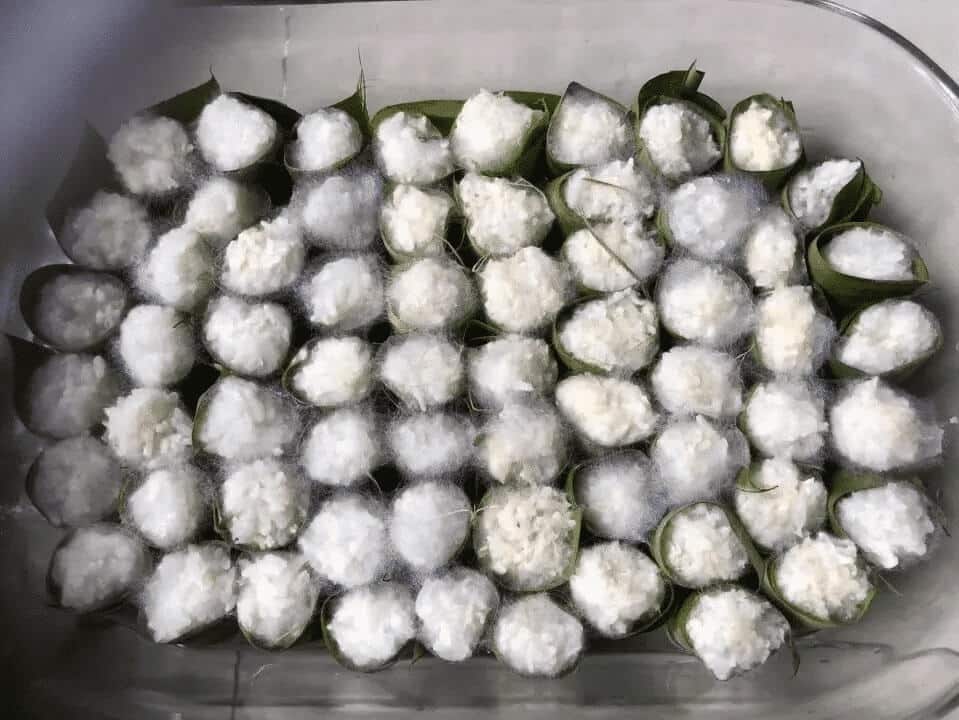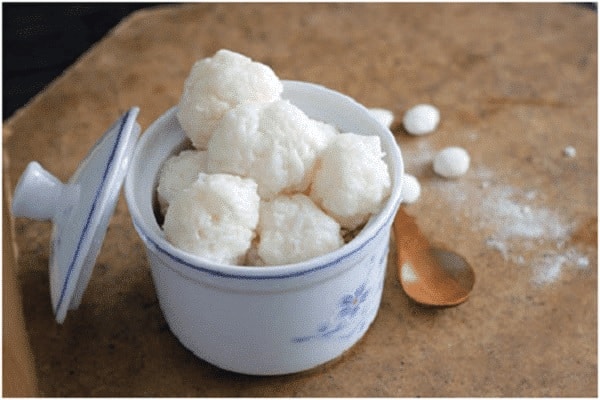1. What is Vietnamese fermented glutinous rice?
Rice is cooked and then fermented with wine yeast for a period of two to four days to produce fermented glutinous rice. It is a classic traditional dish in Vietnamese culinary culture, frequently eaten during the Double Fifth Festival (5/5 lunar calendar).
Standard fermented glutinous rice
Characteristics: Outstanding overwhelming sweetness; very slightly spicy wine fragrance; distinctive perfume; after around 1 bowl or 1 cup of rice, starting to experience a light drunkenness. People may experience a slightly flushed face and an energetic attitude after eating (these effects last 30-60 minutes). Most rice grains are still plump and have not been smashed.
Spoiled fermented glutinous rice
Characteristics: sweet flavor is not overpowering; the pungent taste intensifies, and a sour, sometimes very sour, flavor emerges. The majority of the rice grains are soft (not stretched on the surface).
The sweetness is the result of the yeast cake mold converting starch (rice) to sugar. The pungent flavor of wine is attributable to the activities of yeast in yeast bread, which converts sugar into alcohol. Sometimes the yeast cake contains bacteria, primarily because the temperature is too high (above 30 degrees), which causes the good bacteria to grow quickly and produce lactic acid, giving the food a sour taste.

2. 4 Effects of eatin
It is healthy to consume 0.5 to 1 bowl of rice (or cup) of ordinary wine at a time while also enjoying a very intriguing and pleasant sensation, specifically:
- It stimulates digestion and increases resistance. Fermented glutinous rice contains vitamin B1, iron, and a variety of other vitamins, as well as polyphenol antioxidants and a variety of helpful bacteria, including lactobacillus (found in yogurt). As a result, it aids in the balance of bacteria in the intestine, improves digestion, and boosts immunity.
- Cardiovascular benefits: It contains antioxidants, folic acid, ergosterol, and lovastatin, all of which are beneficial to the heart.
- Quick source of energy: 150g of rice wine has around 205 calories, 4.2g protein, 0.5g fat, and a sugar content of approximately 20-35 brix.
- Reduce anxiety and elevate mood with rice wine's mild alcohol content of 1.5–3 degrees (more than 1/3 of beer, around 1/8 of wine).
3. Common questions
- Is it possible to gain weight by eating fermented glutinous rice?
Excess energy is the source of fat/obesity/weight growth. There are numerous significant factors, the majority of which stem from long-term diets and each individual's ability to absorb.
Obesity is not caused by eating 0.5-1 bowl of rice per day, a few times per week.
- How much does it take to get drunk?
The solution of fermented glutinous rice has a low alcohol level and will not make you drunk (unless you consume 2-3 bowls, or 1-2 kg).
- When should you eat?
Except when you are extremely hungry, you can eat at any time of day. Because it contains very little alcohol, the acid content is sometimes very low (when it initially degrades).
- Does eating fermented glutinous rice cause acne?
A small amount of alcohol is concentrated in fermented glutinous rice. Alcohol is considered hot in Oriental Medicine, making it inappropriate for those with hot constitutions or acne.
- Is it safe to eat fermented glutinous rice?
According to others, eating wine is unsafe since rice wine contains many by-products from the fermentation process and traditional yeast bread contains many contaminants.
Viet Wine compares fermented glutinous rice to wine in that both contain alcohol without being distilled. Aldehydes, methanol... are fermentation byproducts found in wine and also in wine, however the level of those compounds in fermented glutinous wine is significantly lower. Because after 2-4 days of sprinkling the yeast cake, the saccharification process is nearly complete, and the fermentation period begins, at which point we stop and eat it. By-products such as higher alcohols, methanol, and aldehydes created during the fermentation process have just finished, therefore the quantity of such chemicals is lower than in wine. Regarding yeast cakes' impurities, few documents say that they are poisonous like methanol, other than for the fact that they have a bad taste.
=> It is safe to eat fermented glutinous rice and drinking wine, assuming the yeast cakes and fermented processes are proper.
More: Cách loại bỏ methanol trong nấu rượu truyền thống
4. Tips for brewing delicious fermented glutinous rice
4.1 Principles
Fermented glutinous rice is the byproduct of fermentation.
Mold species, yeast species, and contaminants are the three types of microorganisms found in yeast cakes. Each group serves a distinct purpose: mold is in charge of converting starch (rice) into sugar, yeast converts sugar into alcohol, bacteria produce several pollutants that have a disagreeable flavor, such as lactic acid, which causes a sour taste.
The recommended fermentation room temperature is 20-25 degrees. The ideal temperature of the fermenting wine barrel (jar) is 22-28 degrees (higher than room temperature since fermentation generates heat). Molds grow well at that temperature, converting the most starch into sugar, so the wine will be sweet and rich. Miscellaneous bacteria prefer significantly higher temperatures, therefore they do not proliferate rapidly and create relatively little acid (not sour) at that temperature.

4.2 Three things must be accomplished well in order to produce an excellent batch of rice wine:
- Instead of choosing yeast cake to make wine, choose it specifically to make fermented glutinous rice. In comparison to the yeast cake used to make wine, this yeast cake contains more mold and is frequently enhanced with 2-3 times as many sweet herbs (like licorice), and lastly, get a yeast cake from a producer with few contaminants (30% of the importance).
- Choose rice that is not moldy, from a single crop (multiple-crop rice will lose starch content), not processed white like sticky rice, but not completely intact. The bran shell is delicious and high in vitamin B1, but if it is thick and securely wrapped, it makes it difficult for mold to "gnaw and eat" the rice grains to grow, which results in less sweetness and prolonged fermentation. (10% significant).
- Technique is crucial: Rice must be fully cooked, not mushy, and not very dry. Distribute the yeast cake when the rice is slightly warm to avoid being too hot or cold. The fermentation room temperature, in particular, must be as close to the optimal temperature as possible (60% relevance).
The information on wine shown above is what we have learned from working in the wine industry for more than 20 years. This article will continue to be updated. So, in order to enhance the article's quality, we wish to hear from readers. Please leave a comment below the post or send a message to the Viet Wine fanpage if you need help with this.
